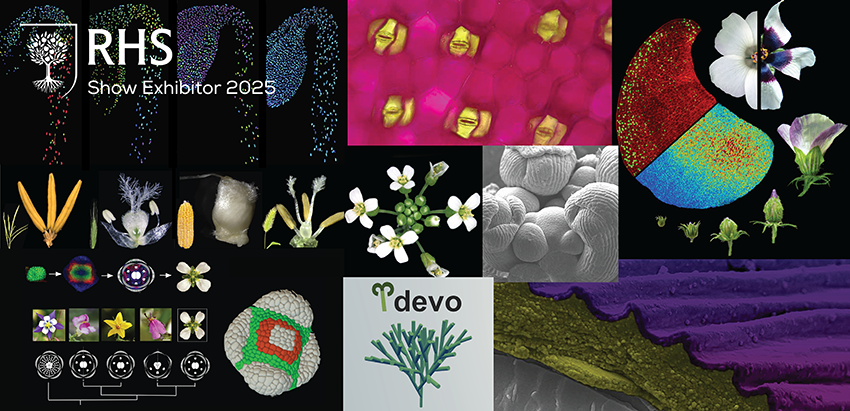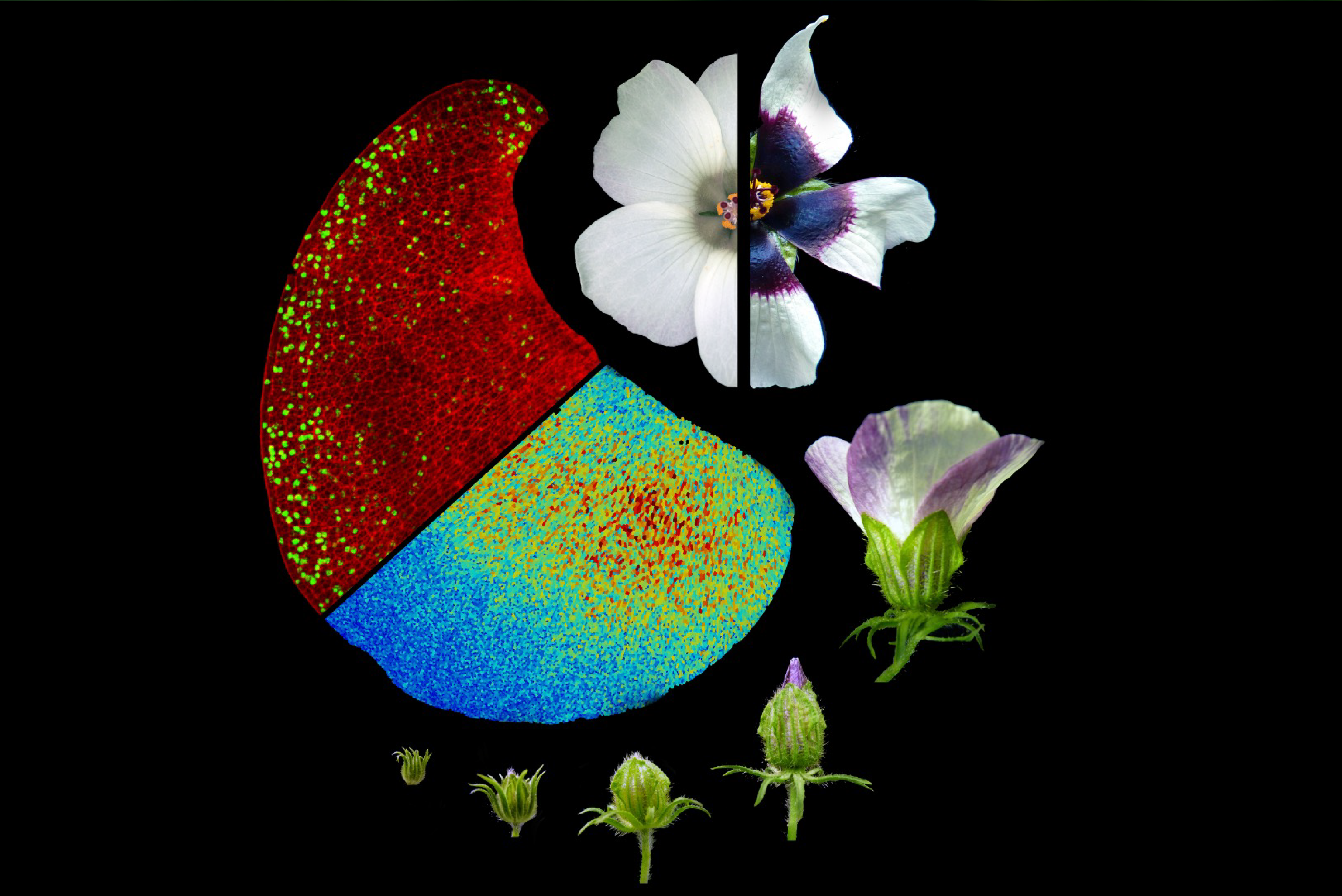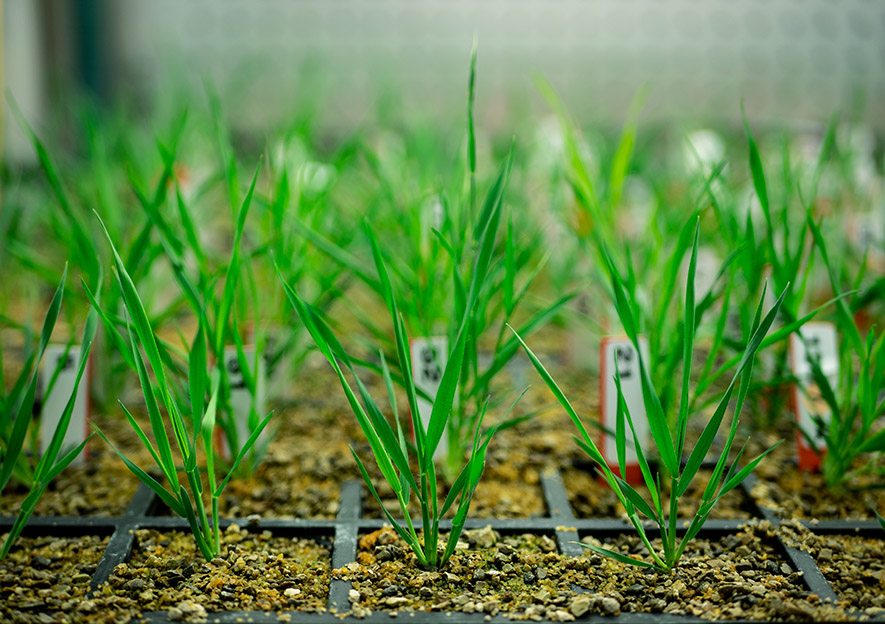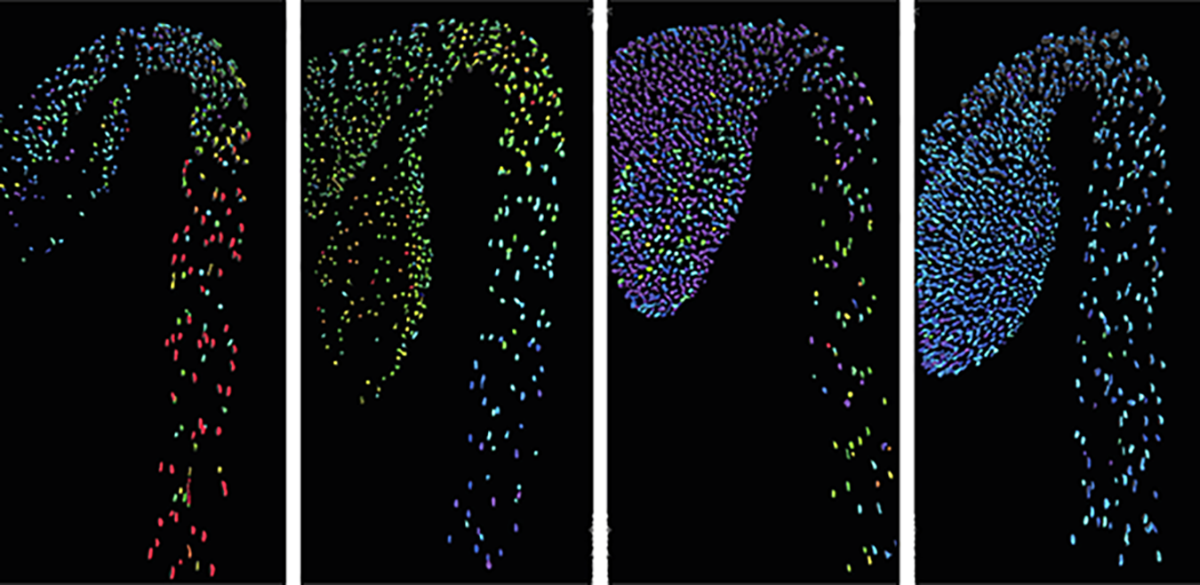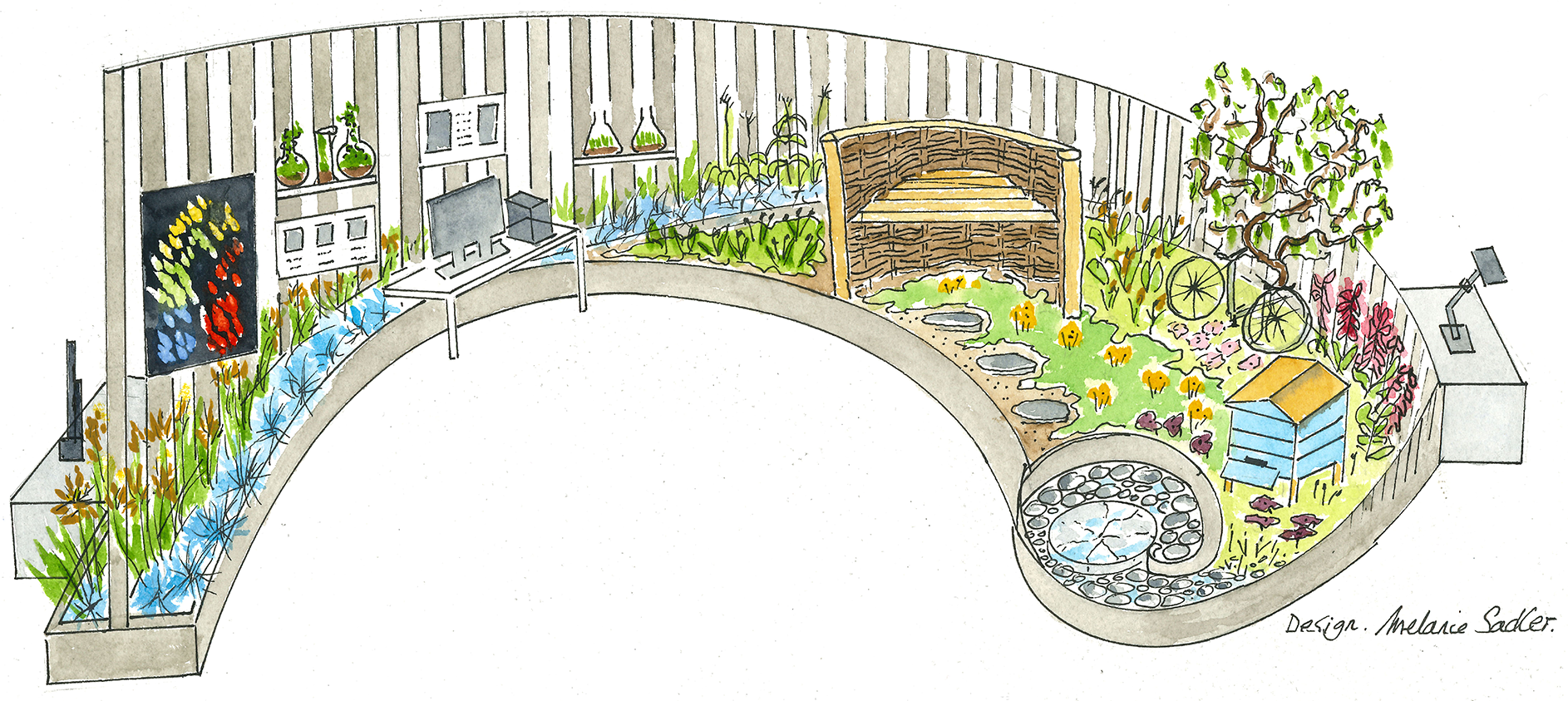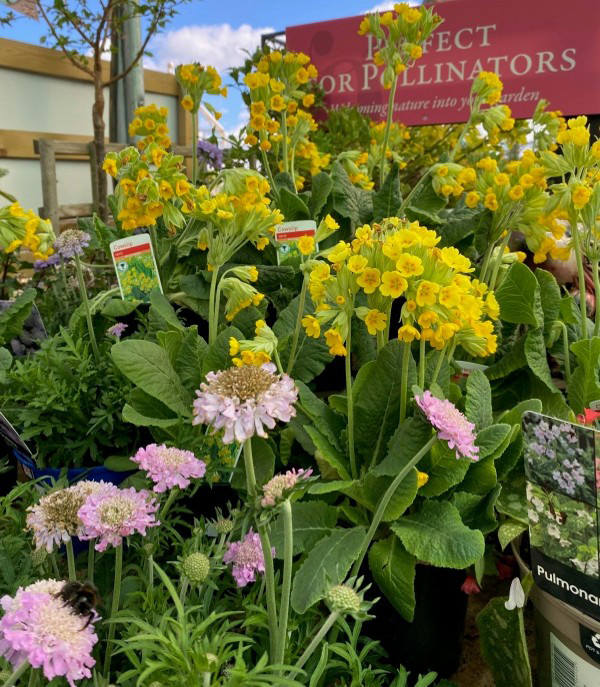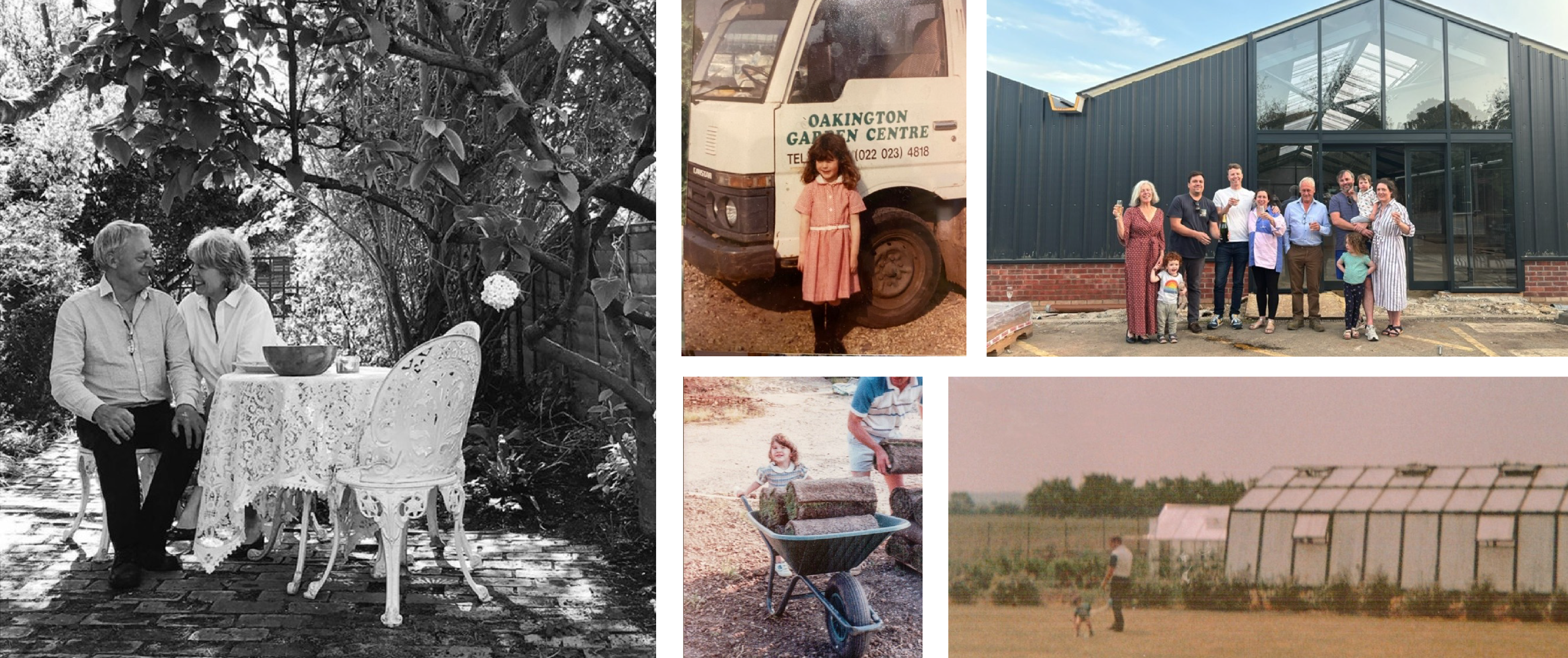Come visit us in the new GreenSTEM section of the Great Pavilion (site GPA005 next to RHS Experience) at the RHS Chelsea Flower Show (20-24 May 2025) and chat to our scientists about their research that is revealing new discoveries about plants
Sainsbury Laboratory Cambridge: Blooming Numbers
Flowers are more than just beautiful. Their colours, shapes, and patterns have evolved specifically to attract pollinators, protect vulnerable pollen and sometimes to even help distribute their seeds.
At the Sainsbury Laboratory we’re fascinated by the dynamic systems that drive plant growth and the development of these remarkable structures.
Our interactive exhibit – Sainsbury Laboratory Cambridge: Blooming Numbers – at the 2025 RHS Chelsea Flower Show's new GreenSTEM section will provide visitors with an insight into the modern plant science research techniques and technologies we use to unlock the complexity of plants.
Visit our exhibit to:
-
Photograph your favourite flower under a scanning electron microscope
-
Use a mini-UV camera to see like a bee
-
Find out about the research project to build a 4D virtual flower
-
Learn how plants move without muscles
-
Discover how flowers use an invisible blueprint that dictates the size of their bullseyes patterns and consequently how attractive they are to bees
-
Hear about new insights into the form and function of specialised floral structures in grasses
-
Explore how noisy genes could help plants survive extremes
-
See how advanced biosensors are letting us observe previously undetectable plant hormones orchestrating growth in plants in real-time
-
Investigate how computer modelling can help us understand plant evolution by building your own plant mini-genome
Where to find us at the RHS Chelsea Flower Show 2025
Our Sainsbury Laboratory Cambridge: Blooming Numbers exhibit will be located in the new GreenSTEM section of the Great Pavilion (site GPA005 next to RHS Experience) at the RHS Chelsea Flower Show (20-24 May 2025).
Sharing our passion for plants at Chelsea
We’re excited to bring our research to the RHS Chelsea Flower Show because it gives us the opportunity to share our fascination with plants with others who share that same passion.
RHS Chelsea Flower Show is an incredible platform to connect with plant lovers, exchange ideas and spark conversations about the amazing, complex world of plants – because for us, there’s nothing more fun and thrilling than discovering the secrets of plants and sharing that excitement with others!
We are proud to have been selected to exhibit in the RHS Chelsea Flower Show's new GreenSTEM exhibit category, which showcases research, technology and innovation in plant science and horticulture.
Flowers like hibiscus use an invisible blueprint established very early in petal formation that dictates the size of their bullseyes – a crucial pre-pattern that can significantly impact their ability to attract pollinating bees. Image by Edwige Moyroud and Lucie Riglet.
Come and discover plants like you have never seen before
You will discover at the Sainsbury Laboratory Cambridge: Blooming Numbers exhibit that plants are far more than just beautiful; they are dynamic and full of surprises! From their ability to adapt to their surroundings, to how they control their complex growth patterns, plants are constantly evolving and responding in ways that will leave you in awe.
Our scientists will take you on an interactive journey through the latest discoveries in quantitative plant science research – beginning with THE FLOWER.
We will demonstrate how cutting-edge tools like computational modelling, machine learning, biosensors, and experimental design are transforming the way we study plants. Whether through data-driven insights or new imaging technologies, mathematics is helping us unlock the complexities of plants.
Close-up of young Brachypodium distachyon plants growing in cellular trays of compost in a controlled environment growth chamber at the Sainsbury Labatory. Image by Nataliia Kuksa.
Plant science's top models
Meet the model plants used by scientists around the world to investigate the fundamental mechanisms of plant growth and development. Some of these plants might look familiar to gardeners but many have never been seen before at Chelsea!
Plants are not simple or sessile
Plants are not simple or sessile – they dynamically respond to their environment, adapting through complex biological processes, from molecular signaling to large-scale ecological interactions.
This means that plant research is also far from simple – it's a complex puzzle that stretches from microscopic molecules to vast plant populations found across forests and fields. Delve into the fascinating science behind dynamic plant life and uncover the intricate processes that drive plant growth, adaptation, and survival by visiting our exhibit at the RHS Chelsea Flower Show.
The diversity in form and function of grass flowers can contribute to grass survival success and grain yield. Image by Madelaine Bartlett and Bartlett Research Group.
Special thanks to our funder and sponsors
Our exhibit is made possible through the generous core funding of The Gatsby Charitable Foundation
We are also incredibly grateful to the work and support provided by Oakington Garden Centre and Department of Engineering at the University of Cambridge who are partnering with us to design and build our exhibit and Leica Microsystems and Strulch for their generous sponsorship.
Visualising plant hormones using biosensors in an etiolated Arabidopsis thaliana (thale cress) seedling. Image from Alexander Jones Research Group.
Exhibit design
Quantitative plant science research
Our researchers at the Sainsbury Laboratory all conduct quantitative research to gather precise, measurable data that can be used to analyse plant growth, environmental factors, and genetic traits. This mathematical-based approach enables us identify patterns, make predictions, and develop evidence-based discoveries about plants.
The design of the Sainsbury Laboratory Cambridge: Blooming Numbers exhibit is inspired by mathematical principles found in nature – in this case we have taken inspiration from the Fibonacci sequence – a mathematical pattern that also fascinated famous Cambridge alums Charles Darwin and Alan Turing.
Darwin's thinking path
The Sainsbury Laboratory building designed by Stanton Williams incorporates a "thinking path" into its plan - inspired by Charles Darwin's circuit around his home garden that he took daily to think, observe, and exercise. There are no dead-ends, which allows you to continue along an internal route where you can run into colleagues, stop and talk, or spill outside into the gardens. At one corner, the public coffee area gives views into the laboratories. In this way, scientists enjoy a more stimulating working environment, while the open approach helps to demystify their work. We have replicated this with our exhibit by keeping it open from all sides allowing visitors to wander along and around the Fibonacci wall to explore our plant science research and chat to scientists and fellow visitors along the way.
The Pollinator Patch
The Sainsbury Laboratory building was also intentionally designed to foster a strong connection with nature with large glass floor-to-ceiling views across the Cambridge University Botanic Garden to inspire and connect scientists and their research with the natural world. To incorporate that into our design, the Fibonacci wall is not a solid wall, but allows views from the lab benches to The Pollinator Patch – a small wildlife friendly garden packed with plants for pollinators and providing other vital resources such as materials for nests, homes and water. The Pollinator Patch has been designed by Melanie Sadler and the team at Oakington Garden Centre are growing all the plants (many from seed) to fill the garden.
Exhibit Designers: Thomas Glenday, Melanie Sadler, Kathy Grube, Dr Dora Cano-Rameriz, Dr Edwige Moyroud, Dr Madelaine Bartlett and Dr Sarah Robinson.
Illustration of the planned Sainsbury Laboratory Cambridge Blooming Numbers exhibit for the RHS Chelsea Flower Show 2025. A Fibonacci spiral will be the central element of our exhibit and guide visitors through a journey along the plant life-cycle starting with THE FLOWER. Illustration by Melanie Sadler.
Media enquires
Please contact Sainsbury Laboratory Communications Manager Kathy Grube by email at katherine.grube@slcu.cam.ac.uk or by calling +44 (0) 12237 61152.
The Pollinator Patch at Chelsea
The Sainsbury Laboratory building was intentionally designed to foster a strong connection with nature. Its purpose is to inspire and connect scientists and their research with the natural world, particularly the historically important and botanically and scientifically valuable Cambridge University Botanic Garden, in which the lab is located.
This connection with the plants that we study is central to the design of our RHS Chelsea Flower Show exhibit.
With THE FLOWER being the starting point, our exhibit narrative takes people on journey through modern plant science research combining experimental lab and computational modelling. We also wanted to reflect our building’s connection with the plants in our surrounding environment.
Oakington Garden Centre is kindly sponsoring our exhibit by growing a selection of plants we use in our research and a diversity of pollinator friendly plants. The Sadler family have integrated wildlife into their business since Melanie and Philip Sadler established their independent family nursery in 1981. The family has been keen beekeepers over the years and are regenerating the land around the Centre with an orchard and wildlife friendly gardens. Last year they held their inaugural Pollination Festival, which they are planning to hold again this year on Saturday 21st June 2025.
So it was a perfect partnership to have Melanie Sadler design The Pollinator Patch, which incorporates a mix pollinator friendly plants, homes for pollinators and a bee-safe water feature.
Melanie Sadler and her daughter Patricia have been incredibly enthusiastic and supportive of the Sainsbury Laboratory's idea to exhibit at Chelsea and help us to share our passion for plants. It has been an absolute privilege to have them join us on this once-in-a-lifetime Chelsea adventure. The whole Sadler family and Oakington Garden Centre staff have worked incredibly hard in an incredibly short timeframe to make our exhibit a reality.
Oakington Garden Centre over time: The Oakington Garden Centre was established by Melanie and Philip Sadler in 1981 and now their three adult children are all involved in running the independant family business with their parents.
About the Oakington Garden Centre
Written by Patricia Sadler
Oakington Garden Centre is a family run business situated on the outskirts of Cambridge. Husband and wife team Philip and Melanie Sadler started it as a plant nursery in 1981 with a handful of polytunnels and a greenhouse. In those days Oakington was a sleepy rural village surrounded by orchards.
Over the next forty years they raised a family on site. The business grew as the area around us developed. Melanie trained as a garden designer in order to give customers starting from scratch support in creating a beautiful garden.
In 2019 we made the decision to start growing on site again. Choosing exactly what to grow, old fashioned or unusual varieties, cutting out the need for deliveries from far flung suppliers has been fantastic. We pride ourselves on being able to offer a really good range of wildflowers, flowering perennials, hedgerow plants and heritage fruit trees. Our nursery manager Ali Chappell-Bates is also a talented professional botanical artist, drawing our shop window to reflect the changing seasons.
All three of Melanie and Philip’s children are now actively involved in the Garden Centre. We care passionately about every garden no matter how large or small being a haven for nature. In 2024 we had our first “Pollination Festival” in order to showcase the importance of plants, ponds, flowers, allotments and gardens for personal and environmental wellbeing.
Find out more about the Oakington Garden Centre
Oakington Garden Centre website
Department of Engineering's Design and Technical Team members who are designing and building the Fibonacci spiral wall for the Sainsbury Laboratory Cambridge exhibit at the 2025 RHS Chelsea Flower Show, from left, Kynan Wright, Thomas Glenday, Dan Boutell, and Barney Coles. Image by Charlotte Hester.
Bringing mathematical beauty to life through engineering design
The design of the Sainsbury Laboratory Cambridge: Blooming Numbers exhibit is inspired by mathematical principles found in nature – in this case the Fibonacci sequence.
The Fibonacci spiral will be the central element of our exhibit and guide visitors through a journey along the plant life-cycle starting with THE FLOWER.
Visitors will follow a circular route around the double-sided spiral wall. This immersive design not only showcases the wonders of plants but also engages visitors in understanding the relationship between mathematics and the natural world.
Turning an idea into reality
Starting with the initial idea of the Fibonacci sequence, Thomas Glenday took on the challenge of designing a curved structure in metal and wood to bring to life the Fibonacci spiral wall.
Thomas, who is the Head of Design and Technical Services, within the University of Cambridge’s Department of Engineering, worked with his team to translate the vision into reality using clever engineering design techniques, while also staying true to the mathematics of the Fibonacci sequence.
"The design of the wall required a balance between artistic vision and engineering precision. The Fibonacci sequence is not just a series of numbers; it's a natural pattern that exists in everything from shells to galaxies. Bringing that to life in metal and wood required careful consideration of form, material, and technique that is both beautiful and structurally sound,” Thomas said.
"One of the most exciting aspects of this project was collaborating with my team. We were able to push the boundaries of traditional fabrication techniques to create something both visually captivating and mathematically accurate. It was a perfect example of how engineering can bring abstract concepts into the physical world.
"It's always rewarding to see a design evolve from concept to reality, but this project felt particularly special as it will be on show to the world at the RHS Chelsea Flower Show. We had to stay true to the mathematics of the Fibonacci sequence while making sure the structure was feasible to build within a tight budget. It’s a testament to what can be achieved with both creativity and technical expertise."
The exhibit design for the RHS Chelsea Flower Show 2025 is just one of the many fascinating projects that the team of engineers and technicians work on.
Current projects include (but are not limited to) developing accessibility solutions, design and manufacture of medical devices and supporting instrumentation, 3D printing high-performance stainless steels (advanced materials with superior qualities); and trialling innovative materials for use in industry sectors varying from aerospace to civil engineering.
Fibonacci sequence in nature
If you look carefully at how seeds on a sunflower are arranged, you will see spiral patterns. The giant flowers are among the most striking – and beautiful – examples of a mathematical principle that governs the patterns of life – the Fibonacci sequence.
In this sequence, each number is the sum of the two preceding ones (1, 1, 2, 3, 5, 8, 13, 21, 34...). This pattern appears in everything from pineapples to pinecones, cabbages, succulents, roses and even the arrangement of leaves around a plant stem.
Spiral patterns defined by Fibonacci numbers have captured the attention of natural scientists and mathematicians alike. The Fibonacci Sequence, also known as the Golden Ratio or Divine Proportion was considered by the Greeks to be the most beautifully proportioned ratio, originating in a place which couldn't be more logical: nature.
Both Leonardo da Vinci and Charles Darwin were captivated by the spiral patterns of plants. The intricate spirals of plants also became the final obsession of British mathematician and Enigma code-breaker Alan Turing, who studied at the University of Cambridge.
Turing mused that the spiral shapes on the heads of sunflowers seemed to follow the Fibonacci sequence, prompting his proposal that by studying sunflowers we might better understand how plants grow.
Our researchers at the Sainsbury Laboratory all conduct quantitative research to gather precise, measurable data that can be used to analyse plant growth, environmental factors, and genetic traits. This mathematical-based approach enables us identify patterns, make predictions, and develop evidence-based discoveries about plants.
Find out about the Department of Engineering at the University of Cambridge
Department of Engineering website
Design and Technical Services at the Department of Engineering
Connect with the Department on Engineering

